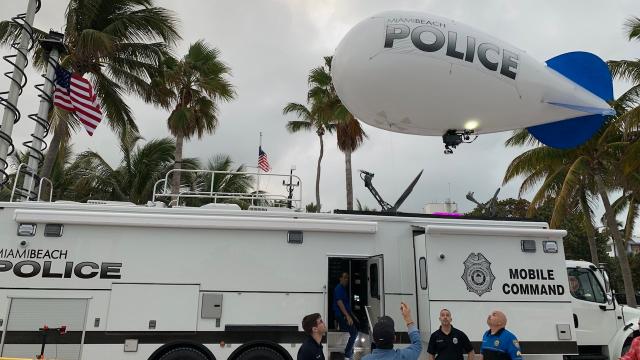The state of Florida passed a law in 2015 banning the use of drones to monitor citizens from the air. But police in Miami Beach, Florida have come up with a clever workaround: They’re using a tethered blimp, called an aerostat, for crowd surveillance and they argue that it’s not a drone.
The Miami New Times reports that the Miami Beach PD started testing different surveillance methods to get around the ban on Memorial Day weekend in 2017, as well as Spring Break and Halloween of last year. But it was only recently that the department purchased a tethered aerostat outright and used it to monitor an Orange Bowl party on December 28.
Miami Beach city manager Jimmy Morales wrote a letter to the city commission last week explaining why the blimp didn’t violate the law.
“Due to the legal restrictions placed on police departments under Florida law and because of limited battery life and flight time, Unmanned Aerial Vehicles (aka “drones”) are not a current option for the Miami Beach Police Department to monitor crowds from the air at large gatherings at major events,” Morales’s letter says, according to the Miami New Times.
Morales reportedly cited terrorism concerns and explained that this is new “smart tech, and it’s safe tech that we’re using to keep folks safe during large events.”
The aerostat can’t move around like a traditional hobby drone might, but it gives police a high vantage point from which to deploy cameras and monitor anyone in a crowd of people.
But it’s not just the Miami Beach PD who are using aerostats on American soil. U.S. Customs and Border Protection (CBP) uses similar aerostats (pictured below) for surveillance and have been for years. The agency first deployed its aerostats at the U.S.-Mexico border in 2013, according to an agency public affairs officer who was contacted by Gizmodo in November when Operation Faithful Patriot first brought thousands of American troops to the border.
“There are currently five Aerostats stationed in the Rio Grande Valley Sector (Falfurrias, Penitas, Sullivan City, Rio Grande City, Roma),” the official told Gizmodo via email. “They are not part of Operation Secure Line and have been here for years.”
Operation Secure Line is the name that was adopted for Operation Faithful Patriot the day after the 2018 midterm elections. The agency declined to provide specs for the aerostats.
Aerostats are often used in warzones and have become “part of the landscape,” as this New York Times article from 2012 explains. But the war always comes home. The sensors, drones, and imaging technology that have been deployed on the battlefields of Iraq, Afghanistan, and Syria in the past two decades have found their way back to American shores to be used on Americans.
In fact, it was recently revealed that CBP flew more drone missions in 2017 than it’s ever flown in its history. It’d be surprising if they didn’t fly just as many or more in 2018. And local police department around the country are hungry for new ways to monitor citizens from above. The New York Police Department even has a fleet of drones for tactical operations now, which it most recently planned to use for monitoring crowds over New Year’s Eve.
Drones are probably coming to your local police department, whether you like it or not. The only question is whether states like Florida that have passed laws prohibiting the practice allow police to get away with calling their drones “blimps.”
